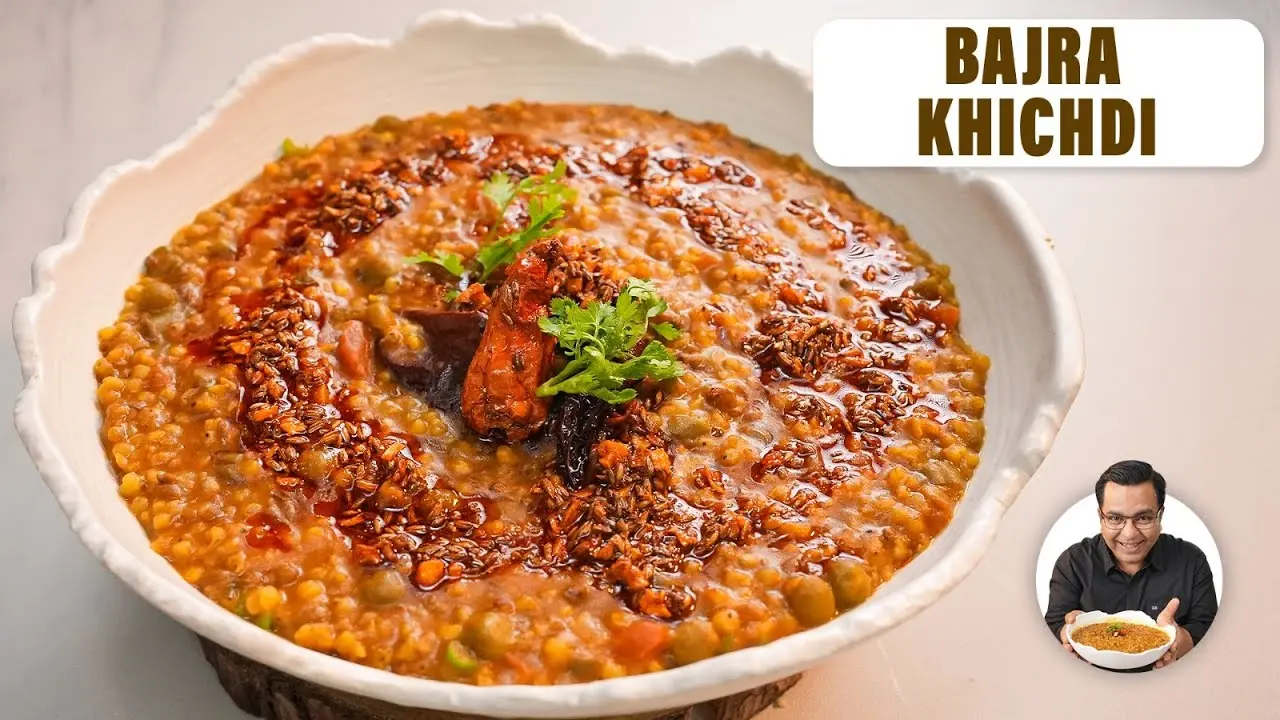
Bajra Khichdi Recipe

50 Mins

5-6 People

10 Mins
Introduction
Bajra Khichdi, a dish close to my heart and a staple in my kitchen. Let me share a little anecdote about my first encounter with this wholesome recipe. It was during a trip to rural Rajasthan, where I had the opportunity to stay with a local family. One evening, as we sat around the fire under the starry sky, the matriarch of the family served us piping hot Bajra Khichdi. The simplicity of the dish belied its incredible flavor and comfort. As I savored each bite, I couldn't help but marvel at how such humble ingredients could create such a satisfying meal. Since then, Bajra Khichdi has been a regular feature in my cooking repertoire, reminding me of that memorable night under the desert sky.
Recipe of Healthy and Tasty Bajra Khichdi
Portions, Serving, and Time:
- Portions serving: 5-6 pax
- Preparation time: 10 min
- Cooking time: 50 min
- Calories: 346 cal per portion
Ingredients:
- Bajra: 1 cup
- Split green moong dal: ¼ cup
- Ghee: 1 tbsp
- Jeera: 1 tsp
- Dry red chilli: 1 pc
- Hing: ½ tsp
- Garlic (chopped): 1 tbsp
- Onion (chopped): ½ cup
- Salt: 2 tsp
- Tomato (chopped): ½ cup
- Turmeric powder: 1 tsp
- Red chilli powder: 1 tsp
- Coriander powder: 1 tsp
- Carrot: ½ cup
- French beans: ½ cup
- Green peas: ½ cup
- Water: as required
Tadka:
- Ghee: 1 tbsp
- Jeera: 1 tsp
- Dry red chilli: 1 pc
- Hing: 1 tsp
- Garlic (chopped): ½ tbsp
- Red chilli powder: 1 tsp
Method: Preparation:
- Rinse bajra and split green moong dal separately. Soak them in water for 30 minutes. Drain and set aside.
Cooking:
- Heat ghee in a pressure cooker. Add jeera, dry red chilli, hing, chopped garlic, and chopped onions. Saute until onions turn golden brown.
- Add soaked and drained bajra and moong dal to the cooker. Stir well.
- Add salt, chopped tomatoes, turmeric powder, red chilli powder, and coriander powder. Mix everything.
- Add chopped carrots, French beans, green peas, and water (enough to cover the ingredients). Mix well.
Pressure Cooking:
- Close the lid of the pressure cooker and cook on medium flame. Allow it to cook for 4-5 whistles or until the bajra and dal are well cooked.
Tadka (Tempering):
- In a separate pan, heat ghee. Add jeera, dry red chilli, hing, and chopped garlic. Saute until garlic turns golden.
- Add red chilli powder and quickly stir. Turn off the heat.
Final Touch:
- Once the pressure cooker depressurizes, open it carefully. Mash the khichdi slightly with the back of a ladle.
- Pour the prepared tadka over the cooked khichdi. Mix well.
Serving:
- Serve the piping hot Bajra Khichdi in bowls.
- Enjoy this nutritious and flavorful Bajra Khichdi as a wholesome meal!
About the Recipe
Bajra Khichdi is a traditional Indian dish made from bajra (pearl millet) and moong dal (split green gram). It is a nutritious and wholesome meal that is commonly consumed in regions like Rajasthan, Gujarat, and parts of Maharashtra. Bajra, known for its high fiber and protein content, provides energy and satiety, while moong dal adds a creamy texture and enhances the nutritional value of the dish.
To prepare Bajra Khichdi, bajra grains are soaked overnight and then cooked with moong dal, along with spices like cumin seeds, turmeric, and green chilies. The result is a hearty and comforting khichdi that is perfect for a nourishing meal, especially during winters. Bajra Khichdi is often served with a dollop of ghee (clarified butter) and accompanied by pickle or yogurt for added flavor and balance.
Cooking Tips
-
Soaking Bajra: It is essential to soak bajra overnight to soften the grains and reduce cooking time.
-
Consistency: Adjust the consistency of the khichdi by adding more water for a thinner consistency or reducing water for a thicker, porridge-like texture.
Pairing Guide
-
Beverage: Pair Bajra Khichdi with a warm cup of ginger tea or a refreshing glass of chaas (buttermilk) for a satisfying meal experience.
-
Side Dish: Serve with a side of tangy mango pickle or cucumber raita to complement the flavors of the khichdi.
Frequently Asked Questions about Bajra Khichdi
-
What is Bajra Khichdi?
- Bajra Khichdi is a traditional Indian dish made from bajra (pearl millet) and moong dal (split green gram), flavored with aromatic spices.
-
Is Bajra Khichdi gluten-free?
- Yes, Bajra Khichdi is naturally gluten-free as bajra is a gluten-free grain.
-
Is Bajra Khichdi healthy?
- Yes, Bajra Khichdi is highly nutritious as it is rich in fiber, protein, and essential vitamins and minerals.
-
Can I make Bajra Khichdi without soaking the grains?
- While soaking bajra overnight is recommended to reduce cooking time and improve digestibility, you can cook it without soaking, but it will require longer cooking time.
-
Can I add vegetables to Bajra Khichdi?
- Yes, you can add diced vegetables like carrots, peas, or potatoes to Bajra Khichdi to enhance its nutritional value and flavor.
-
How long does it take to cook Bajra Khichdi?
- Cooking time for Bajra Khichdi may vary depending on the method used and the consistency desired, but it typically takes around 30-40 minutes.
-
Can I make Bajra Khichdi in a pressure cooker?
- Yes, you can cook Bajra Khichdi in a pressure cooker for faster cooking. Follow the instructions for cooking lentils and grains in your pressure cooker.
-
Is Bajra Khichdi suitable for weight loss?
- Yes, Bajra Khichdi can be a part of a weight loss diet as it is low in calories and high in fiber, which helps in keeping you full for longer.
-
Can I use other lentils instead of moong dal in Bajra Khichdi?
- Yes, you can use other lentils like masoor dal or tuvar dal instead of moong dal in Bajra Khichdi for variation in flavor and texture.
-
Is Bajra Khichdi a complete meal?
- Yes, Bajra Khichdi is a complete meal as it combines grains and lentils, providing a good balance of carbohydrates, protein, and essential nutrients.
